Riding safely during COVID-19, or any time you’re on a bike
With the COVID-19 pandemic forcing people around the world to stay home and practice social distancing, we might all be feeling a little bit cooped up and stressed out. For those of us who are well, bicycling can still be a way to de-stress and get necessary physical activity. So Bicycle Colorado has put out a short series of articles on how bicycling is still a great way to keep ourselves happy and healthy. The information in these articles applies every day, but even more so in these weeks to come.
Today, we’re talking about how to get out and ride safely! We discussed bicycling’s benefits for your physical health on Monday, its benefits for your mental health on Tuesday, and its benefits on our air quality Wednesday.
Bicycle Colorado continues to be reminded that there is a lot of good in our communities during the uncertain times caused by the COVID-19 outbreak. Our supporters and fellow bike advocates are also showing the world that riding bikes can lift our spirits, health and help us feel connected in the age of social distancing.
We also know that hospitals and the healthcare industry are extremely strained and we want to be sure they can continue to focus on addressing COVID-19 cases. To help bicyclists like you keep yourself safe and avoid injury in a time of limited resources—and any other time!—we’ve put together this summary of our safety tips and Colorado laws for bicyclists.
Please keep in mind that educating riders is just one part of our work. We are continuing to advocate daily for systems-level design changes and funding to support safer infrastructure for all users, and we also acknowledge drivers’ responsibility as they operate heavy, high-speed motor vehicles. We will be hosting a Bicycle-Friendly Driver webinar on Friday, March 27 to support those who are out in their cars.
Note: The information below is provided as a public service. It is not legal advice and should not be interpreted as such. Bicycle Colorado also realizes that equipment, route selection and riding behaviors will depend on access to resources and the confidence level of each rider.
How to prepare

Your bike, what you wear and what you bring can all help you ride safely or avoid injury. Below, you’ll find a few recommendations to help you be as prepared as possible before heading out on a ride.
Find the best route
Do your best to research any route you’re riding, and especially if you’re riding it for the first time. Cross-check with other route-finding options, which may sometimes need further refining based on your comfort level. Many municipalities have bike maps that highlight local routes and infrastructure. Google Maps can generate a bike-specific route and has a “bicycling” layer you can select in their menu to see bike infrastructure. The Strava app and heat map can show where others (often quite confident riders) are already riding. If you’re a beginner, you might want to find an experienced rider to help you identify the best route or guide you on the first ride. Remember, if you ever feel uncomfortable navigating an area on your bike, you can always dismount and walk!
Personal identification and charged cell phone
These are important to have in an emergency. Megan Hottman, AKA The Cyclist Lawyer, has a very informative post about what to do in the event of a crash.
Helmet
Wearing a helmet is a good proactive measure you can take to lessen the severity of a head injury in some crashes. Here’s Mo explaining our Two-Finger Test to ensure your helmet is fitted properly to protect your head.
Clothing
Even the clothes you wear can help you prevent a crash. Avoid loose clothing that could catch in your bike’s chain and be sure shoes are tied before taking off.
Bike check
It’s important to check that our bike is safe to ride. Before hopping on, we encourage you to do a 30-second (at most!) ABC Quick Check. Here’s Chris explaining each step for your air, brakes, chain and quick releases.
Lights
When riding after dusk in Colorado or when visibility is poor, bicyclists are required by law to have at last a white front light and rear red reflector (we recommend a red light), as well as side reflectors. Not only will these accessories help you be seen, but they can help you see where you are going and avoid obstacles. Biomotion lights that emphasize the circular motion of your feet or wheels are proven to increase visibility of bicyclists.
Recumbent cycles
Because recumbents and some hand cycles have a lower profile, riders might attach a flag to draw drivers’ attention. They might also take steps described below to help drivers see them.
Above and beyond
Riders can go above and beyond with equipment to increase visibility and document drivers. Some bicyclists will wear reflective or neon gear to be seen, mount a mirror on their helmet or bike to monitor approaching drivers or install a camera to record interactions on their ride. To be clear, these are not measures required by law, nor should they be seen as necessary to go out and enjoy a ride.
How to ride legally in Colorado
In addition to some of the equipment requirements mentioned above, here are some laws that are written to help keep us safe and riding predictably for other road users. For official language and more detail about Colorado bicycling laws, visit ColoBikeLaw.
Bicycles are vehicles
Bikes are vehicles by Colorado state law and bicyclists have the same rights and responsibilities as drivers of motor vehicles.
Follow all traffic signs and signals
Bicyclists should follow all rules of the road, including speed limits, traffic lights and stop signs. The only Colorado communities where bicyclists can treat stop signs as yield signs or red lights as stop signs at this time are Aspen, Breckenridge, Dillon, Summit County and Thornton.
Refuse unlawful courtesies
Follow right of way rules. Entering an intersection before it is your turn, even when invited to do so by generous drivers, leads to miscommunication and potentially unpredictable and dangerous situations. Put your foot down, give them a smile and encourage others to follow the right of way.
Ride with traffic
Like other vehicle operators, bicyclists must ride with the flow of traffic when on the street, even in traditional bikes lanes. An exception is a contraflow bike lane that is well-marked and often separated to safely allow riding against traffic.
Ride to the right
Bicyclists should ride as far to the right of the travel lane as they judge safe. In addition to adjusting for safety, they may leave the right side when they are preparing for a turn or passing another road user.
Take the lane
To reinforce the above, bicyclists have the right to ride in the center of the lane (hence “Bicyclists may use full lane” signs), whether or not there is designated bike infrastructure. The middle of the lane can sometimes be the safest positioning to avoid obstacles or poor road conditions, be more visible or discourage passing in narrow sections of the road.
Hand signals
Adults are required to communicate with hand signals when preparing for a turn and when it is safe for them to take a hand off the handle bars.
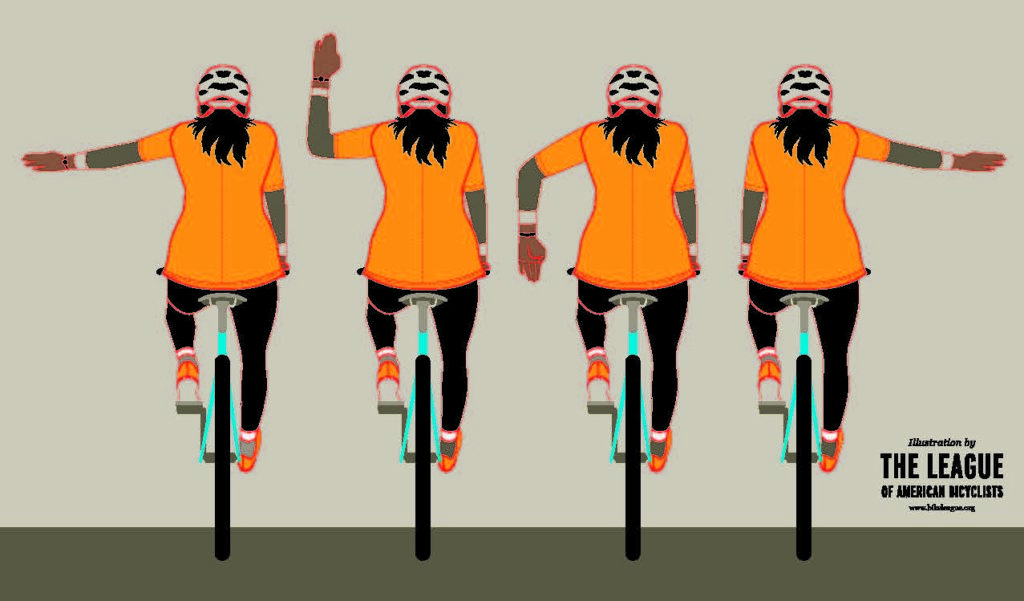
The image above shows for common hand signals (from left): Signaling a left turn, signaling a right turn, stopping, and signaling a right turn again. In Colorado, bicyclists may use either right turn signal.
Two abreast
Bicyclists may ride two abreast (side by side) if they are not impeding the flow of traffic. Sometimes bicyclists might choose to ride together to increase visibility.
Three feet of space
When passing, drivers are required to give bicyclists at least three feet of space between the outermost part of their vehicle or any projections and the bicyclist. They are also allowed to cross a double yellow line to provide this three feet minimum.
Keep pedestrians safe
Yield to people walking or rolling and communicate with them before passing on the left. Most trails have a speed limit of 15mph for the safety of all trail users.
How to ride defensively
Even though a bicycle is a vehicle, we know there are unique differences between bikes and cars that make people on bikes more vulnerable. Below are ways to ride defensively, which means riding cautiously, staying visible and being prepared to react. On the road, we are the only ones sure to be looking out for ourselves and can never assume that a driver sees us.
Ride on the street
When not on separated trails, generally, the safest place for most adult riders is on the street where you are more visible to drivers. Some municipalities in Colorado do restrict adults from riding on sidewalks because of the frequency of crashes at sidewalks and driveways or intersections. Check your communities’ website to find out if that applies to you.
Scanning
Scan thoroughly as you ride, particularly before changing lanes or proceeding through an intersection.
Intersections
Most crashes between drivers and bicyclists happen at intersections. Give yourself space at intersections to avoid being blocked by other vehicles or shadows, avoid lane-splitting and pass drivers on the right only with plenty of room and caution.
Parked cars
Give yourself enough room alongside parked cars to avoid doors opening in your path and leave space to react to drivers pulling out of their spots.
Weather
Ride defensively through rain, snow or ice, realizing that it may be harder for drivers to react or see you in these conditions (even though drivers should be aware of the same and traveling slower themselves!)
Headphones
While it is not illegal to wear headphones while riding, we want to note that using them can prevent you from hearing your surroundings and riding as defensively as possible, which is especially important when our healthcare system is already under stress. Headphones have also been used in courts to “victim shame” riders involved in a crash, regardless of fault.
Eye contact
People outside of cars are often told to make eye contact with drivers. This can be helpful when you have strong vision, are within a close distance, when windows aren’t tinted and when a driver is making an effort to see you, too. If you are in a situation where you aren’t sure whether a driver sees you, exercise defensive riding and wait until they travel across your path first.
Common crashes
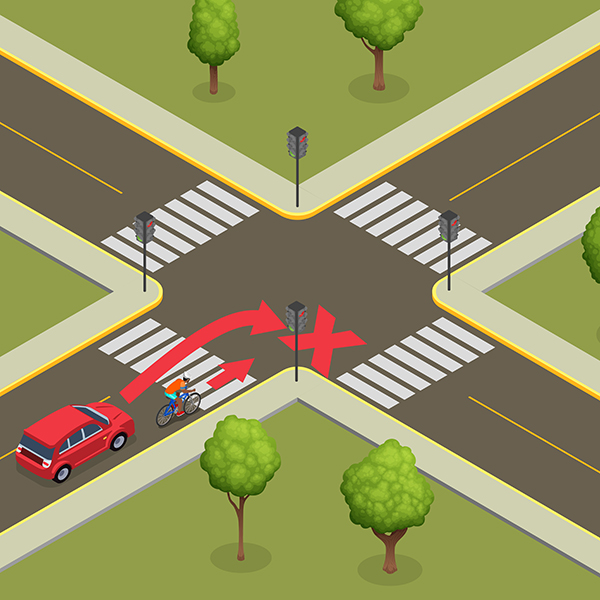
The Right Hook
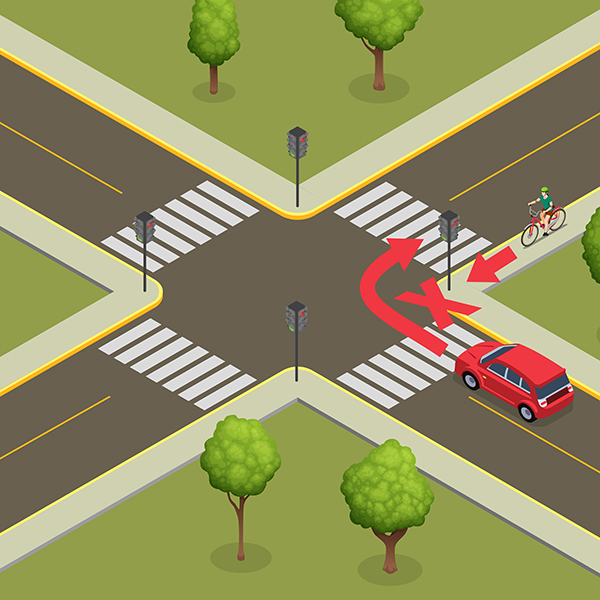
The Right Cross
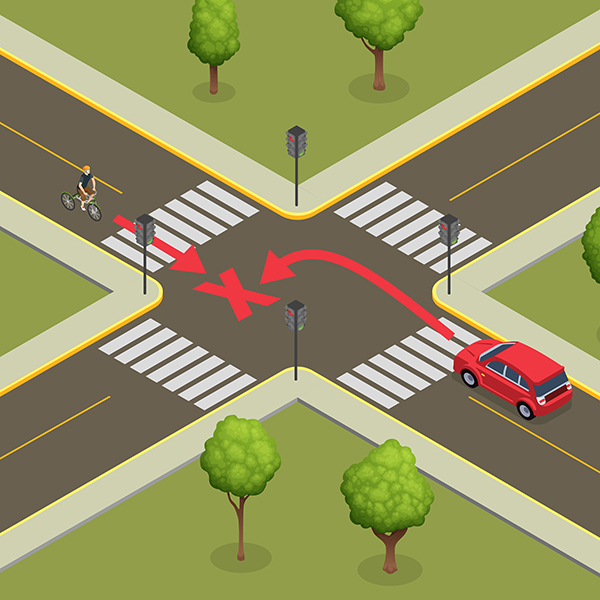
The Left Cross
How to ride in winter
Spring doesn’t always mean the end of winter weather. Here are some safety tips specifically for those snowy and icy conditions.You can also hear Bicycle Colorado’s Senior Communications and Policy Manager, Jack, discussing winter riding on
Colorado Public Radio by clicking here.
Tires
Choose wider tires, studded tires or a lower tire pressure for more traction.
Navigating snow and ice
Go slow and avoid braking and turning at the same time through snow and ice. Coast straight through icy patches or dismount and walk your bike.
Sun
Be aware that the low position of the sun during winter commutes can make it difficult for drivers to see you. Make defensive decisions about positioning and when to cross drivers’ paths when you feel their vision might be compromised.
Plowing
Don’t settle for unplowed streets and bike routes that can be perilous for bicyclists. Report conditions to your local municipality, and offer them praise when they keep up with plowing.
How to ride on the trails
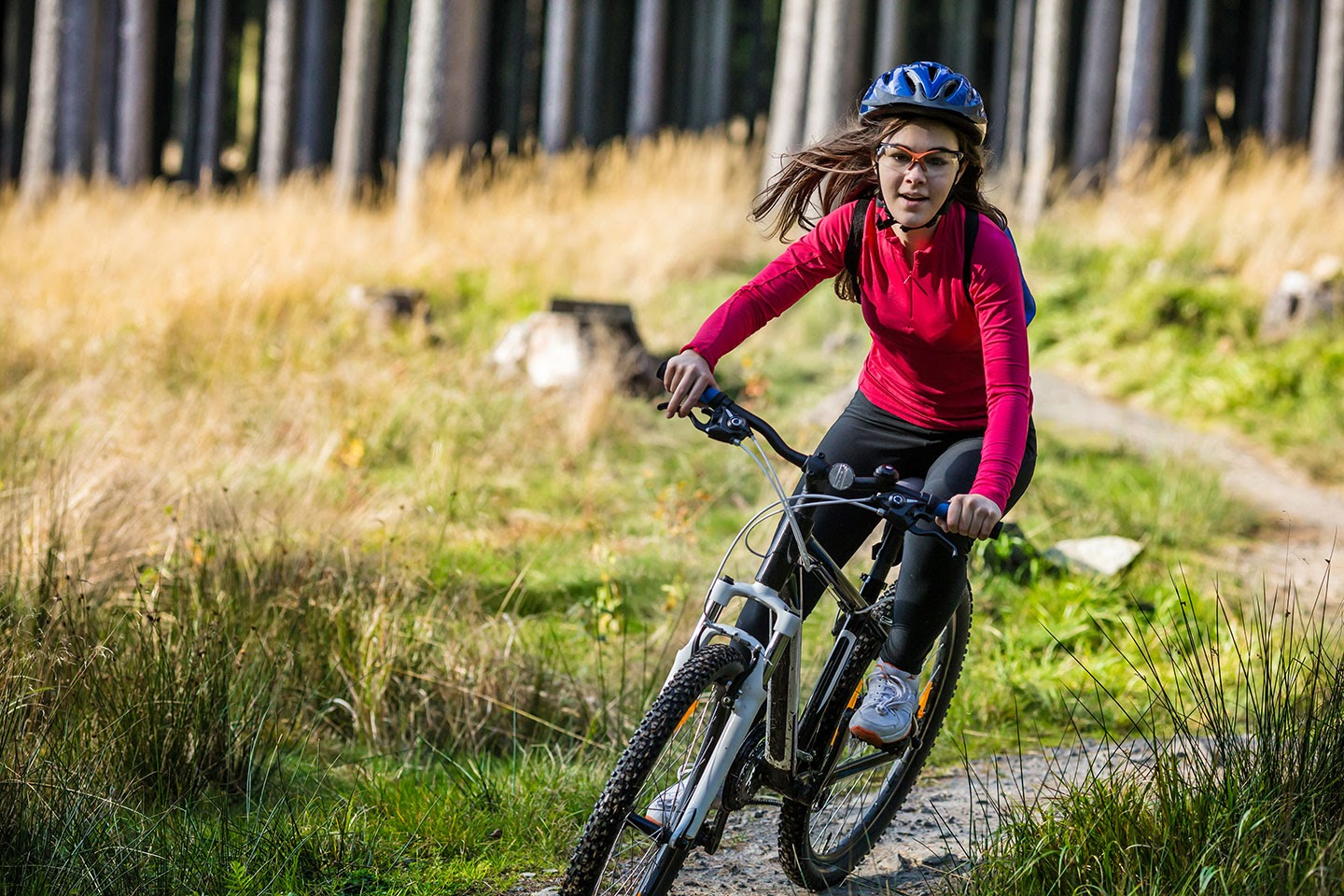
Riding off-road has become a popular pastime as a way to social distance while enjoying scenic Colorado. If you’re planning to ride trails, Colorado Trail Explorer (COTREX) and TrailForks are great apps for finding and mapping routes. Conditions are ever-changing, however, so check with your local government or trail management groups for up-to-date information on usage and access. This can usually be found on their website or social media page.
The International Mountain Bicycling Association (IMBA) recently published an article about trail usage during the COVID-19 outbreak which is worth a read here. Below are also IMBA’s rules of the trails to ensure everyone is riding responsibly and keeping themselves and each other safe so hospitals can focus their attention where it is needed most.
IMBA's Rules of the Trail
- Respect your local trail builders and be a good steward of the physical environment. Keep singletrack single by staying on the trail. Practice Leave No Trace principles. Do not ride muddy trails because it causes rutting, widening and maintenance headaches. Ride through standing water, not around it. Ride (or walk) technical features, not around them.
- Most of the trails we ride are multi-use. Mountain bikers yield to horses and foot traffic, and descending riders yield to climbing riders. This yield triangle has been formally adopted by land managers since the late 1970s and is a significant reason why we have the access we do. There are some regional differences and unique rules on single-use, directional mountain bike trails—know the code where you ride. Be nice. Say hi.
- Poaching trails, building illegal singletrack or adding unauthorized trail features are detrimental to our access. Poorly-built features could also seriously injure other trail users. If you believe there aren’t enough trails or variety near you, it’s time to get involved. Your engagement will be welcomed because it takes a village to create, enhance and protect great places to ride.
- Speed, inattentiveness and rudeness are the primary sources of trail conflict among user groups. If you need to pass, slow down, ring a bell or verbally announce yourself, and wait until the other trail user is out of the path. Use extra caution around horses, which are unpredictable. Be extra aware when riding trails with poor sight lines and blind corners, and make sure you can hear what’s going on around you.
- Be prepared and self-sufficient. Every mountain biker should carry what they need for the ride they’re undertaking, and know how to fix a flat tire and make minor repairs. Download a GPS trail app on your phone for navigation or carry a map in unfamiliar locations. Ride with a partner or share your riding plan with someone if you’re heading out solo.
- When it comes to wildlife, live and let live. In some places, running cattle and disturbing wildlife are serious offenses. If you want to ride with your dog, first find out whether or not it’s allowed by looking up the leash laws. Be prepared to take care of your dog. Ensure your companion is obedient enough to not cause problems for you, other trail users or wild animals.
Bicycle Colorado is doing everything we can to improve the many factors that affect riders’ safety. We hope this information helps you exercise what you have control over when you’re on the roads and that it doesn’t distract from the many wonderful reasons we ride. Have additional tips? Send me an email at maureen@bicyclecolorado.org.
In the meantime, I hope you’ll get out there and enjoy a bike ride!
Your membership makes resources like this possible.
Leave A COMMENT
Our twitter feed is unavailable right now.
The Latest News
view all- Jun 13, 2024
- by Bicycle Colorado
Discover Denver With Denver Century Ride
- Bicycling in Colorado,
- Denver,
- Event Member Spotlight,
- Events
- No Comments





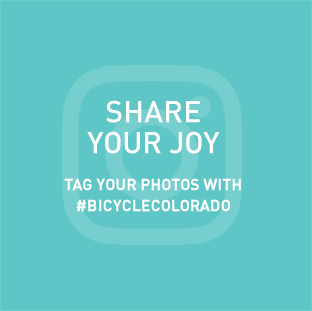

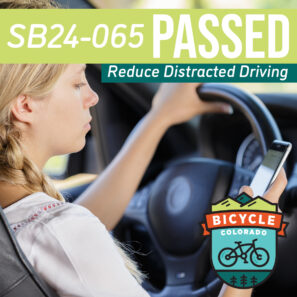
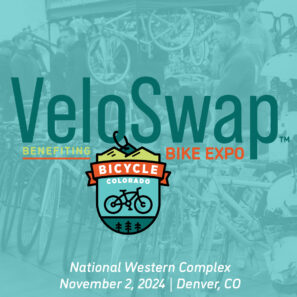
COMMENTS (10)
Cynthia Ord -
Hi Maureen,
Thanks for all this coverage — I’m so appreciative of the work you do!
Question: I was on the Platte Trail in Denver yesterday on my bike, and it was so crowded. There’s no way people on bikes could stay 6 feet apart. I had a buff over my mouth but of hundreds of other riders, only saw 5 or 6 others covering their mouths. It was the most exposed to strangers I’ve felt in weeks.
Do you guys have any advice or guidelines on using the urban trails right now?
Aishwarya Krishnamoorthy -
Thanks for your support, Cynthia! The recommendations that we’ve seen are that if a trail or open space is too crowded to maintain a 6-foot distance from others, you should leave the area and try to find a new space. The Rails-to-Trails Conservancy has some good guidance here: https://www.railstotrails.org/trailblog/2020/march/24/using-trails-and-outdoor-spaces-safely-in-the-wake-of-covid-19/
Good luck and stay healthy!
Mo McCanna -
Thanks so much for reading, Cynthia, and for your concern about safety on the trails. I must be missing the crowds with my timing or stretch of the trail, I’ve been riding the Platte from 8th to downtown in the morning for some fresh air.
I will defer to Aishwarya’s response and resources since she and our communications team are following the most up-to-date recommendations. Unfortunately, if the issue is numbers, safest practice is riding elsewhere. If you plan to stay on the trail, we hope the Rails-to-Trails guidance is helpful, although it does look like they’re advocating for street closures as well. Safe riding and stay well!
Jim Williams -
My new passing alert is ‘Socially distancing on your left” Folks tend to chuckle.
Mo McCanna -
What a respectful and appropriate announcement, Jim! We might have to steal that one.
Brooks Bryant -
Hi Mo-
My son is a “bored” by riding the same routes from our home repeatedly. As the weather has gotten warmer, he wants to put the bikes on the car rack and drive to Boulder for rides (we live in Denver). Is that allowed these days?
Thanks!
Jack Todd -
Hi Brooks,
Thanks for your question!
Technically your son isn’t prohibited from doing that, but we strongly discourage him from doing so. State officials (and us at Bicycle Colorado) are asking everyone to stay as close to home as possible, and only travel for essential trips. Following that guidance is the best way for people to limit the spread of the virus, even if they have no reason to think they may have it. We’re asking all bicyclists to do their part to flatten the curve at this time.
Thanks again.
– Jack
Sue Foppe -
What is your position on wearing masks while riding? I too, am a frequent bike path rider and have seen many walkers, runners and other cyclists without masks. I wear a bandana and try to look away when I’m passing non masked people but sometimes that’s just not possible.
Aishwarya Krishnamoorthy -
Hi Sue! Although recent research seems to suggest that a person isn’t likely to come into contact with a load of virus big enough to do any harm just by being passed or passing on a trail, we encourage bicyclists and other folks moving near others to use masks because it reduces the risk of transmission even more. In addition, we’re encouraging leaving as much space as possible given the trail or path conditions, and a minimum of 6 feet of separation at all times. Thanks for doing your part!